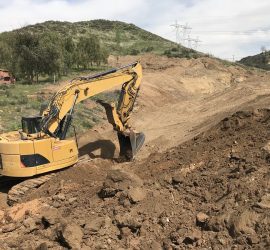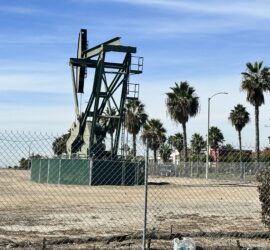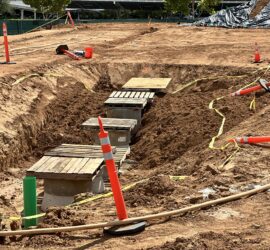Health and Safety Plan for Environmental Construction
A construction health and safety plan (or HASP) is an organized program that aids to prevent accidents and injuries during work. In the environmental engineering industry, workers are exposed to numerous safety hazards on-site. For example: heavy equipment; drilling machinery with pinch points; slip and trip hazards; open trenches; and more. A HASP also accounts for the potential hazards by exposure to suspect chemicals of concern. As a result, companies prepare and maintain a site-specific health and safety plan, for each project and scope of work. Moreover, a comprehensive HASP also helps companies stay compliant with labor laws and regulations. Updated January 8, 2021.
Safely Forward
“Safely Forward” is Geo Forward’s in-house construction health and safety plan program. History demonstrates that job-site safety is best-accomplished with proper training and education. Consequently, this initiative keeps all field personnel aware and alert about the potential safety hazards at a job site. In fact, Safely Forward comprises a continuing education program. The ultimate goal is to educate workers in the industry with modern-day employment rules, laws, and regulations.
Field Safety Auditing
Safely Forward also includes a field-auditing and coaching system, which constructively monitors workers on the job. The goal is to eliminate dangerous habits by workers, and systematically replace them with the safest methodologies. In like fashion, worker application of the best-practices are also rewarded to encourage continued health and safety plan management.
Health and Safety Plan Management
Today, there are a wide range of safety management procedures for employers (as well as their employees) to implement. In fact, companies that emphasize on a construction health and safety plan culture are highly recognized via social medias. The reputation of a company that aims to protect the lives of its workers, and their families, goes a long way in modern society.
Best Practices
Some best practices for construction health and safety plan management are:
- Always involve workers in the safety process through project briefings, by offering safety incentives and hosting daily tailgate meetings prior to starting work.
- Perform random fieldwork safety audits to make sure personnel are properly implementing the safety procedures.
- Continue training personnel year-around.
- Equip all onsite personnel with the appropriate level of Personal Protective Equipment (PPE).
- Appropriate a field safety officer for each project, to analyze potential site safety hazards.
- Train the field safety officer to evaluate risks, communicate them, and set up control measures.
Health and Safety Plan
For each day of fieldwork, Geo Forward performs a site-specific Health and Safety Plan (HASP) tailgate meeting. A construction health and safety plan identifies the safety procedures to guide the field activities at the Subject Site. The details of a HASP apply to everyone on-site. For instance, Geo Forward employees, contractors, regulatory agency personnel, responsible parties, and any other individual who attends the Subject Site during fieldwork. Government agency inspectors must also observe the safety rules and regulations set forth by the HASP.
Open Door Policy
It is very important to have an open door policy for all workers to report hazards, accidents, near misses, and injuries. Thorough investigations of any near miss or accident should be reported, company-wide. This is to ensure effective action is taken. Upon any event (for instance, a near miss or miss), it is important to update the site-specific construction health and safety plan, to now consider the information exposed by the recent event. Similarly, there is a requirement to update the company training program for workers and subcontractors. Moreover, on-site staff must-have assignments to follow the new rules.
Daily Pre-Field Tailgate Meeting
All field personal must review the site-specific HASP prior to entering the construction exclusion zone. A daily pre-field health and safety meeting is a requirement at the beginning of all on-site activities. And follow-up meetings are also necessary at the beginning of each workday then after. This process continues until the completion of fieldwork. A project HASP serves as a continuously active document and repeatedly undergoes updating and revision as the project develops. The original health and safety plan is a basis of past experiences and available site-specific information at the time of preparation. If actual site conditions or operations vary from the original HASP, there is an obligation for the site safety officer to reflect those changes accordingly.
A site-specific HASP undergoes development and updating, using the reasonable person standard. A proper safety plan is in general conformance with modern safety standards. However, any concerns in the furtherance of the general standards are the direct responsibility of a site safety manager.
Plan References
At a minimum, Health and Safety Plan reports are based on the following references:
- National Institute of Occupational Safety & Health (NIOSH)/OSHA/United States Coast Guard (USCG)/Environmental Protection Agency (EPA) Occupational Safety and Health Guidance Manual for Hazardous Waste Site Activities
- California Occupational Safety & Health Administration (Cal/OSHA) Title 8 California Code of Regulations (CCR) 5192
- American Conference of Governmental Industrial Hygienists, Inc. (ACGIH) Threshold Limit Values for Chemical Substances and Chemical Agents.
- Occupational Safety & Health Administration (OSHA) Title 29 Code of Federal Regulations (CFR) 1910 & 1926
- NIOSH Pocket Guide to Chemical Hazards
Personal Protective Equipment (PPE)
The proper level and use of personal protective equipment is the responsibility of each worker on-site, as well as the site specific safety manager. PPE has the sole purpose to protect everyone within the exclusion zone, and enduring the job site environment. At a minimum, typical environmental engineering sites require steel-toe boots, hardhats, ear protectors and eye goggles. Equally important is the use of high-visibility clothing. Visibility is very crucial and is actually a requirement for all tasks across the board. In fact, PPE is a major topic within any Health and Safety Plan.
Construction managers, site safety directors and all other on-site personnel must regularly verify that their coworkers are wearing the correct gear. Bear in mind that each item of PPE is necessary, per the context of the work being performed.
Soils Management Plan & Safety
A Soil Management Plan is a typical requirement for excavation projects with environmental concerns. For instance, an underground storage tank removal and abandonment project. One major component of any Soil Management Plan is the Site-Specific Health and Safety Plan. In fact, many aspects of the soil excavation process today, surround worker and public safety. The safety plan within a soil excavation management plan aims to make sure all workers and occupiers of a property are free of harm and health risk exposures.
Sources:
United States Department of Labor: Occupational Safety and Health Administration





